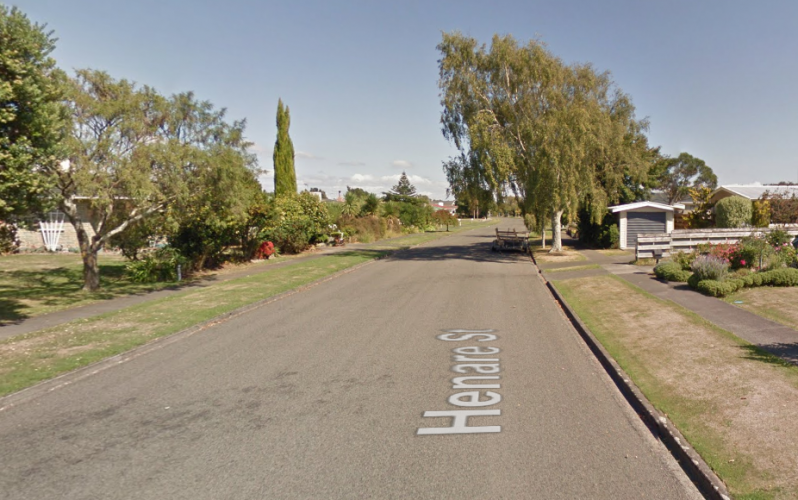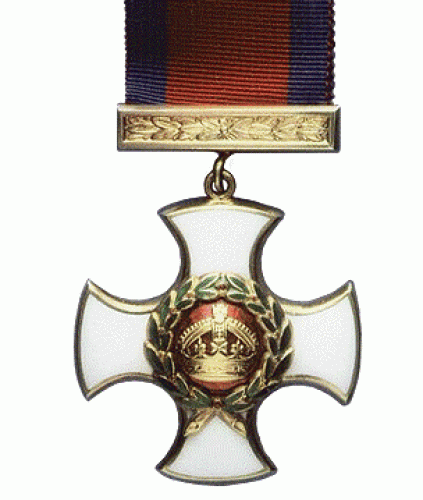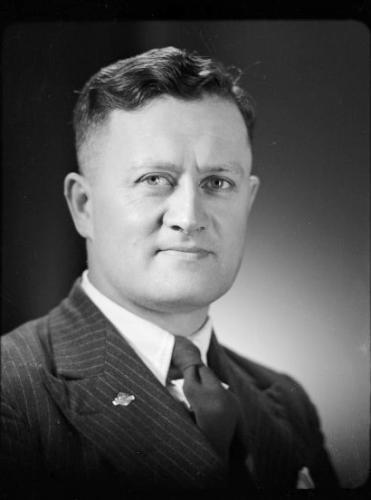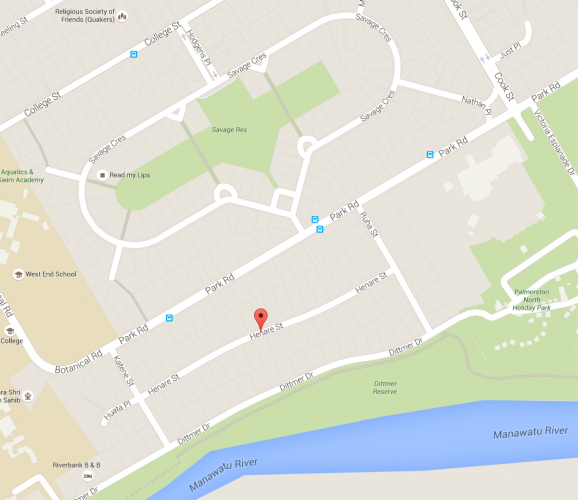093 Henare St Palmerston North, street scene 2017
Reason for the name
This street was named in honour of Lieutenant Colonel James Clendon Hēnare DSO, 28th Maori Balttalion
Prior to its subdivision, the land known as Awatapu was a golf course and grazing area situated next to the Manawatu River. In order to free up land for residential development and increase revenue, a Council meeting of 16 April 1963 resolved to subdivide the area via “disposal of sections through Land Agents at pre-determined figures fixed by the Council”. The new Awatapu College had to be allowed for, and the old Awatapu Golf Links shifted upstream to Brightwater Terrace, which then became the Palmerston North Golf Club. The main access road through the area was at first known as Awatapu Avenue.
Henare Street runs parallel to the long-established Park Road and is surrounded by other prominent 28th Māori Battalion names. The western end of the street is intersected by Katene Street, which then feeds into the cul-de-sac of Huata Place. The eastern end runs perpendicular to Ruha Street, with Dittmer Drive running parallel to the street on the southern end. The Palmerston North Holiday Park, Awatapu College and historic Savage Crescent are also in the area.
As part of the process of subdividing and naming streets, George Dittmer was contacted in late 1964 to give his thoughts on the naming of streets after 28th Māori Battalion soldiers as a commemoration of their service to their country. Dittmer provided a comprehensive list of soldiers who had served under him which was later utilised by the Council to adopt further street names in the Awatapu subdivision. Hēnare, being commander of the Battalion at the end of World War II and a recipient of a Distinguished Service Order (DSO), was one of the prominent individuals selected for this honour.
Author: Evan Greensides, Research Assistant for the Palmerston North City Library
James Clendon (Himi Te Nana) Tau Hēnare was born at Motatau in the Bay of Islands on 18 November 1911, the youngest of six sons and one of eight children of Hera Paerata and her husband, Taurekareka (Tau) Hēnare. The family’s ancestry connected them to a number of great northern warrior chiefs, including Kawiti and Hone Heke. James was also the great-grandson of Colonel Robert Wynyard, who commanded British troops in the Northern Wars. Taurekareka’s election as Member of Parliament for Northern Māori in 1914 changed the family’s lifestyle markedly; James was first enrolled at Motatau Native School and subsequently won a scholarship to Te Aute College in Hawke’s Bay. After finishing his high school education, James enrolled at the newly established Massey Agricultural College, at his father’s urging, to study for a diploma of dairy technology.
Marked from childhood for special guidance by his elders, James was told that, as well as receiving a Pākehā education, he had to be trained in whakapapa and tikanga, in order to fully serve his people in later life. The influence of northern and national Māori leaders was strong in the young Hēnare’s life. Nicknamed ‘The Bishop’ because of his grave manner, he was closely associated with Peter Buck, a former Northern Māori MP and Department of Health medical officer familiar with the Hēnare family. Occasionally journeying to Wellington with his father, James also spent time at the homes of Māori MPs Sir James Carroll and Sir Maui Pomare.
On 2 August 1933, at Otiria in the Bay of Islands, James Hēnare married Roiho Keretene (Rose Cherrington). James’ father’s death in 1940 saw him assume a leadership role, further reinforced by Tau Hēnare’s death-bed exhortations to his son to serve in the war. As the mangai (spokesperson) for northern Māori, Tau Hēnare felt responsible for sending young Māori to their deaths in the First World War. This burden, he believed, could now be relieved by his own son’s enlistment. Signing up for service in the 28th New Zealand (Māori) Battalion, Hēnare quickly attained a commission in August 1940, training as an officer at Trentham Military Camp.
Hēnare left New Zealand with the 5th Reinforcements and served with the 28th Māori Battalion in the North African and Italian campaigns from 1941 to 1945. He was promoted to captain in 1942 and was wounded at the critical Battle of El Alamein in October 1942. After arriving in Italy, Captain Hēnare led Ngapuhi of A Company during the Battle for Orsogna, followed closely by the epic battle for Monte Cassino. It was his actions at Cassino that would earn him the Distinguished Service Order (DSO), the citation of which noted his fearlessness and courage, specifically singling out his company command in February 1944.
Hēnare was promoted to major in September 1944, later becoming a commander of Headquarters Company. In June 1945 he succeeded Arapeta Awatere as commanding officer of the battalion and attained the rank of lieutenant colonel. The battalion was ready for engagement in the Pacific when Japan surrendered and Hēnare brought his men home to New Zealand in January 1946. War experience matured Hēnare; he believed he had acquired greater ability to concentrate and to discern the essentials in any situation, and that he had become more methodical. Hēnare was mentioned in dispatches multiple times throughout World War II, all of which make note of his inspirational leadership in action with the Battalion.
Declining an offer from Te Puea Herangi of land and a leadership role amongst Herangi’s people, Hēnare returned to the family farm at Motatau. Apart from a period in Auckland as district Māori welfare officer from 1951 to 1956 with responsibility for Auckland City, South Auckland and Tai Tokerau, he was to live at Motatau until the mid-1970s, when he retired to Kawiti, near Orauta.
James Hēnare’s post-war life was marked by a commitment to public service, education and leadership of his people. His father had fought for recognition of the Treaty of Waitangi throughout his life, and James continued this commitment, stating, ‘It is the burden of Tai Tokerau to argue the Treaty’. He had been a member of Te Runanga o te Tiriti o Waitangi, a committee of descendants of the chiefs who signed the treaty. James Hēnare was made a Knight of the British Empire in 1978, having earlier received the honour of Commander of the Order of the British Empire.
Sir James Hēnare died at Kawakawa on 2 April 1989, survived by his wife and children. In a display of his importance and impact upon New Zealand society, Sir James Hēnare’s tangihanga at Otiria marae, Moerewa, was attended by the Māori Queen, the governor general, the prime minister and former war comrades. He was buried at Motatau with full military honours.
Companion of the Distinguished Service Order (DSO). Awarded on 30 April 1946. The citation reads:
Major Henare has fought with 28 New Zealand (Māori) Battalion for nearly four years. He has been a platoon commander and company commander and has always shown fearlessness and courage of the highest order. He commanded one of the companies which took part in the attack on Cassino Railway Station on 15 February 1944. In this battle very heavy opposition was met and it was only by superb courage that Major Henare was able to lead his men on to their objective despite many casualties. His complete fearlessness in this action was an example to all about him. Later he commanded his company in the Rimini battle with equal gallantry. He then became second in command and temporarily took over command of the Battalion between the River Reno and the River Po on the 23 April 1945 when his courage and energy inspired a tired battalion to new efforts and resulted in the mopping up of the enemy south of the River Po. Major Henare's bravery has throughout his service been an example to the whole battalion.
- 1939-1945 Star
- Africa Star (8th Army clasp)
- Italy Star
- Defence Medal
- War Medal 1939-1945 with oak leaf
- Coronation Medal 1953
- Silver Jubilee Medal 1977
Hēnare stood unsuccessfully for the New Zealand National Party in the Northern Māori electorate in 1946. He later became a member of the Rehabilitation Board, the New Zealand Geographic Board, the Board of Māori Affairs, the Bay of Islands County Council, Tai Tokerau Māori Trust Board and the Bay of Islands Maritime and Historic Park Board. He was also active in the Order of St John, the RSA, Rotary and Federated Farmers of New Zealand. His dedication was recognised when he was made a Commander of the Most Excellent Order of the British Empire (CBE) in 1966 and a Knight Commander of the Most Excellent Order of the British Empire (KBE) in 1978. He also received an honorary LLD from the University of Auckland in 1986.









